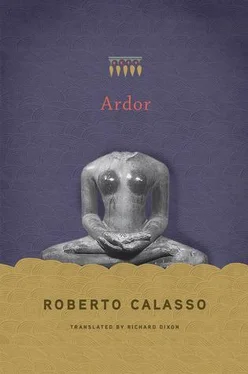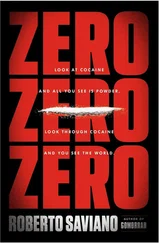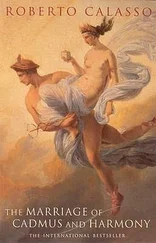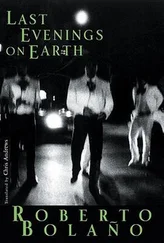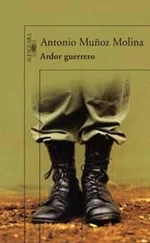* * *
The final dilemma over the sacrifice emerged when Soma was killed. There was then an exchange between the gods and Mitra, whom the sacrificer recalls at the moment when soma is mixed with milk:
“He mixes it [ soma ] with milk. The reason he mixes it with milk is this: Soma was really Vṛtra. Now, when the gods killed him, they said to Mitra: ‘You kill him too!’ But he did not like it and said: ‘I am certainly a friend ( mitra ) of all; if I am not a friend, I will become a nonfriend ( amitra ).’ ‘Then we will exclude you from the sacrifice!’ He said: ‘I also kill.’ The cattle moved away from him, saying: ‘He was a friend and has become a nonfriend!’ He was left without cattle. Mixing [the soma ] with the milk, the gods then supplied him with cattle; and likewise now this [officiant] supplies it [to the sacrificer] mixing [the soma ] with the milk.
“And to this they say: ‘Surely he did not like killing!’ So the milk that there is in this [mixture] belongs to Mitra, but the soma belongs to Varuṇa: and so it is mixed with the milk.”
Sacrificing implies complicity in the killing. Only in this way is it possible to avoid being excluded from the sacrifice. And this must be a far more serious threat, if Mitra, the Friend, the one who represents the brahmin’s purity, is prepared to take part in the killing, so as not to be excluded from the rite. But what is to be lost by being excluded from the sacrifice? Everything — if what there is to be gained is a result of action. And if action comes from desire. Anyone who accepts the action — and the desire that prompts it — also accepts the killing. It is the inflexible rule of sacrificial society, in this respect similar to — and perhaps the model for — every secret society, every criminal society. The group is based on complicity — and the most solid complicity comes from killing. That this then consists of pressing the juice of a plant can offer no form of reassurance. Indeed, it allows us to see how the realm of killing is larger than we might imagine, as large as the world.
* * *
Any reference to the invisibles in Vedic times is not to be interpreted as a metaphysical allusion, but as referring to a situation that recurs in all “solemn,” śrauta , rituals. Those present belong to four groups: the sacrificer, for whose benefit the rite is celebrated (he is present, but, once he has been through the consecration, he plays no active part); the officiants (sixteen: the hotṛs , the udgātṛs , the adhvaryus ), who have to pronounce the verses of the Ṛgveda , chant the melodies of the Sāmaveda , murmur the formulas of the Yajurveda while the countless gestures that make up the ceremony are performed (this being the exclusive task of the adhvaryu ); the brahmin, a priest who watches every detail and intervenes only when errors are made, otherwise remaining silent. But a last group is also there: the gods, invisible presences. Or more exactly: those who are crouching around the āhavanīya fire, on fragrant layers of kuśa grass, entirely invisible apart from Agni and Soma. Agni is always visible, for he is the fire. King Soma is visible in the agniṣṭoma , because in that rite it is the soma itself that is offered.
After being purified with the pavitra —the “filter,” which in this case is made of stalks of a sacred herb — for “impure, indeed, is man; he is foul within, insofar as he speaks untruth,” the sacrificer folds his fingers one by one toward his palm, evoking a different power for each, because he wants to take hold of the sacrifice. And the commentator adds: “The sacrifice is not in fact to be taken hold of visibly, as this staff or a garment, but invisible are the gods, invisible the sacrifice.”
Every sacrificial practice, beneath every sky, implies a relationship with the invisible, but never as in the India of the Vedic ritualists has that relationship been declared, celebrated, studied down to the tiniest details, including even the movements of the little finger. Thus we discover that the little fingers are the first to be moved in the gesture of taking hold of the sacrifice, and represent nothing less than the mind. This continual fluctuation between minuscule and huge, with equal attention to both, is the primary hallmark of Vedic liturgy. And such is the tension and the precision of that intense, ceaseless relationship with the invisible, that it is no surprise that the visible scene of Vedic life remained so bare, so unimpressive, so averse to all monumentality. And it is no surprise that its inhabitants had such a lack of interest in leaving behind any trace that was other than textual or whose object was not to be found in that invisible which could not be grasped like a staff or the hem of a garment, but was nevertheless to be grasped. The invisible is like the onetime forest animal — it is the prey that the liturgy teaches us how to hunt, showing us how to prepare the ground, how to stalk it, how to catch it. And finally how to kill it, as happened in hunting, and is now repeated in sacrificing.
There is one ultimate question on sacrifice, after all the others: why does the offering to the invisible have to be killed? Suffocating the animal, pressing the soma , grinding corn: all these are considered acts of killing. And already this suggests an intensity of thought, a concern to clarify that elsewhere was not felt necessary. But for the Vedic ritualists this was only the penultimate question. It was bound up with another, which they asked repeatedly: why is the celebration of a sacrifice also the killing of the sacrifice? Why, in the case of the sacrifice, does its performance have to involve not just the execution of the victim, but that of the sacrifice itself? Why is the sacrifice an act that not only kills, but kills itself?
Here we enter the most arcane area of Vedic liturgical speculation, an area in which it becomes increasingly difficult to find parallels in other civilizations. And it is an area where we have to move with caution, since “the gods love what is secret,” as the texts never tire of repeating, as soon as we cross the threshold of the esoteric.
Why then does the sacrifice itself have to die, every time it is performed? And why does it then have to be performed again? The sacrifice is never a single act, nor can it ever be. The single act is the killing: the knife that slashes a body, the arrow that pierces it. But the sacrifice is — and has to be — a sequence of acts, a composition, an opus. Everything converges slowly, meticulously toward the oblation or the immolation. Hours, days, even months (or years) at one extreme; just a few seconds at the other. The sacrifice requires time. And it requires the existence of time as something clearly marked out. But we know from what happened to Prajāpati that the articulation of time is the same as the disjointing of the Progenitor, his dismemberment into the Year, therefore his death: “When [Prajāpati] became disjointed, the vital breath went out from within him.” And, what was even more serious for the Progenitor of the gods, Prajāpati felt a dread of death: “Having created all existing things, he felt emptied and was afraid of death.”
Life Below requires death Above, in the same way as life Above demands death Below. For the gods to continue living, it is necessary to perform a killing. For men to continue living, the Progenitor has to be dismembered in the world. This is the ṛta , “world order”—or, at least, it is one of its fundamental principles. But this is not enough — and points to something else. There cannot be a smooth flow, an undisturbed exchange, between the visible and the invisible. There is a sudden gap between the two poles, which can only be bridged through precise and complicated measures. Measures so complicated that they can absorb a whole lifetime. Sacrificial killing is the most apparent and most serious of these. If the offerings circulated between sky and earth, if they didn’t have to be accompanied by a violent act, there would be an immediate correspondence between the visible and the invisible. The invisible would appear at any moment in the world, which would thus come to lose its opacity, its harsh muteness. Life would be a great deal easier — and less hazardous. But it is not like this. Every awakening is matched by a radical uncertainty over everything — and, if the agnihotra had to be celebrated every day just before sunrise, it was because there was no guarantee that this would happen. Perhaps Sūrya, the Sun, needed help.
Читать дальше
